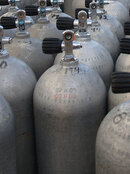If you are aware that the tanks you are diving are out of hydro and visual and you choose to take the chance and dive them then you are aware of the risks involved and the possibility of an explosion. However if enough divers complained to management about unsafe tanks and took their business to another shop that had safe equipment maybe things would change. You don't have to wait until you are on the boat to check out the gear.
I suspect a lot of diver going to that destination will be now looking at the hydro dates, viz stickers and older Luxfer and Walter Kidde tanks. Unfortunately it often takes a tragedy before things change.
I feel sorry for the dead employee. I am sure he knew they were cutting corners but because he needed a job so he did not bring up the issue with his boss or maybe his boss just did not care. Sadly he is the one that paid the price because his employer did not do it right.
I had two Walter Kidde tanks. I cut the tanks off at the shoulder and used them to make a display for some of my double hose regs.
Quite a few assumptions in there.
This whole subject has been an eye opener for me.
Of course in OW training there is some stuff on tank markings, but in nearly 80 dives I have never checked the inspection dates on a single tank. Being a relatively new diver, I just presumed these issues were of a rarity that I didn't need to worry about it. New divers have more immediate issues like buoyancy and gas management to think about. Then a level of complacency sets in once you 'think' you know something about diving.
This board- and the Accidents section in particular- have been invaluable for waking me from my slumber. Risks such as diving too deep, for too long, expansion injuries, getting bent- are all under own control. Issues like an exploding tank spook me most. Goes without saying I will be checking every tank inspection date from now on. The odds are on our side, but risk without reward is stupid it pays to be diligent. Checked on the dock before leaving, the worst that can happen is that the boat master thinks you are a pain in the ass for wanting a different tank.
---------- Post added September 3rd, 2014 at 11:02 AM ----------
I honestly never check the tanks. I can dive the tanks on the boat, or refuse, so as long as it passes my testing - I go. The explosion risks are pretty much at the fill shack, maybe the way they are delivered. Once on the boat, even if one did explode - we'd all be there for it anyway.
Agree that a tank failure is most likely during or shortly after filling. It can still take time for it to go. I would rather the tank wasn't on my back or by my legs if it did.
I would still like to get hold of some real data on tank failure frequency. I suspect it is a very rare event but like this one- so lethal when it happens- that we could easily give it more weighting than it is due. You are probably right. Bad air is probably a much bigger risk.
Does anyone keep or publish statistics on these events?





